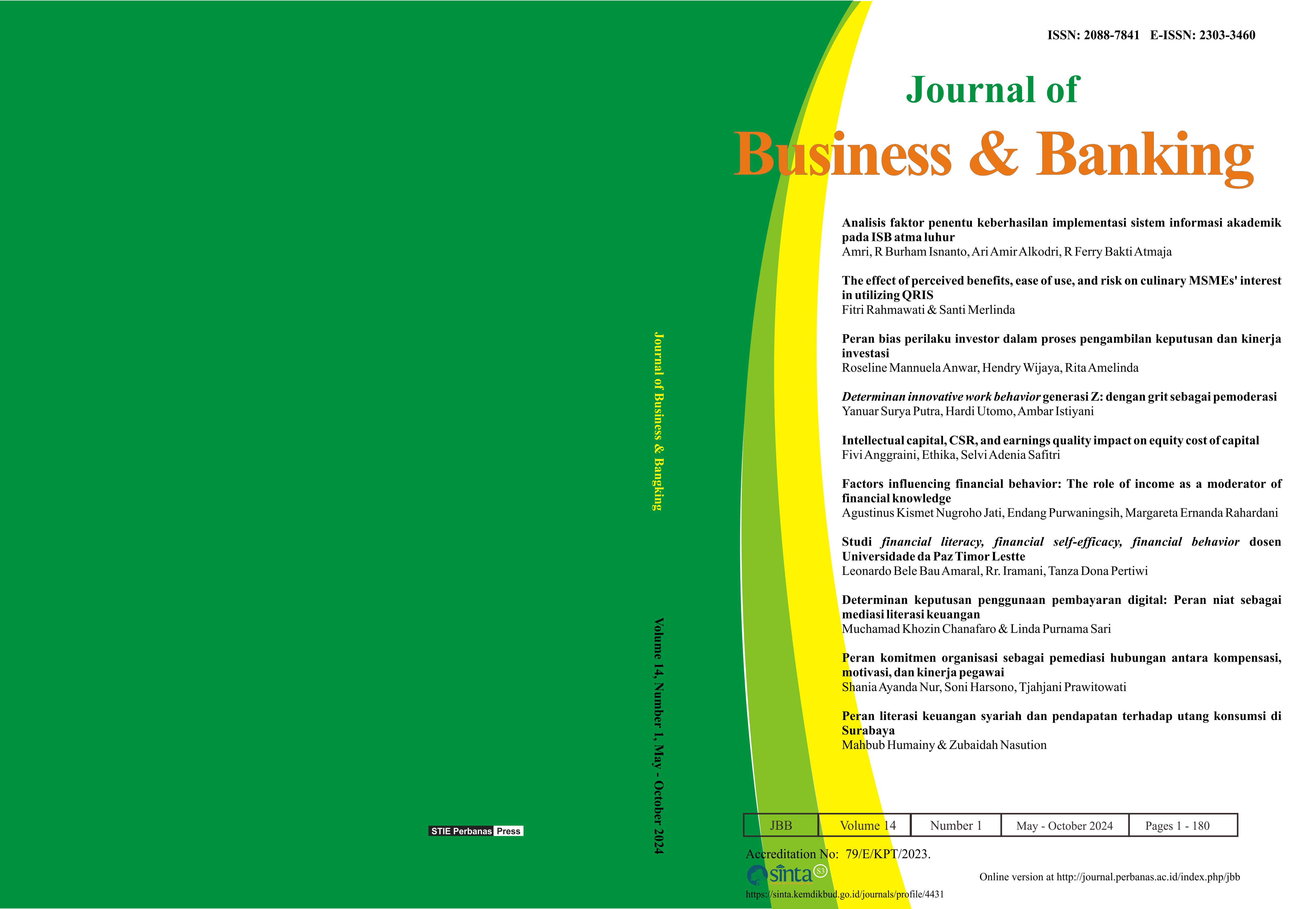Determinan keputusan penggunaan pembayaran digital: Peran niat sebagai mediasi literasi keuangan
DOI:
https://doi.org/10.14414/jbb.v14i1.4993Keywords:
Keputusan penggunaan pembayaran digital, Literasi keuangan, Persepsi risiko, Gaya hidup, NiatAbstract
This study aims to examine the influence of financial literacy, risk perception, lifestyle, and the use of digital payments, all of which are mediated. by intention, on Generation Z in Surabaya. This study uses quantitative methods and purposive sampling techniques involving 175 Generation Z respondents in Surabaya. The data analysis technique uses a structural equation model with partial least squares (SEM-PLS). The results of the study indicate that financial literacy has a direct influence on the intention and use of digital payments, while risk perception does not directly affect the intention to use digital payments but directly affects the use of digital payments. Meanwhile, lifestyle does not directly affect the use of digital payments. This study proves that the intention to use digital payment applications is able to mediate the influence of financial literacy on the use of digital payments. Yet, the intention to use digital payment applications is not able to mediate the perception of risk in the use of digital payments. It can be implied that financial literacy is important for increasing the use of digital payment applications for Generation Z in Surabaya through high intentions.
References
Aisyah, M., & Sesunan, Y. S. (2023). Decision Making on The Use of a Shariah-Based E-Wallet by Indonesian Consumers. International Journal of Data and Network Science, 7(4), 1739–1752. https://doi.org/10.5267/j.ijdns.2023.7.017.
Ajzen, I. (1991). The Theory of Planned Behavior. Organizational Behavior and Human Decision Processes, 50(2), 179–211. https://doi.org/10.1016/0749-5978(91)90020-T.
Audina, M., Isnurhadi, & Andriana, I. (2021). Faktor yang Mempengaruhi Behavioral Intention Transaksi Keuangan Digital (E-Wallet) pada Generasi Milenial di Kota Palembang. Media Riset Bisnis & Manajemen, 21(2), 99–116.
Davis, F. D. (1989). Perceived Usefulness, Perceived Ease of Use, and User Acceptance of Information Technology. MIS Quarterly: Management Information Systems, 13(3), 319–339. https://doi.org/10.2307/249008.
Dayan, M. T. (2020). Pengaruh Persepsi Konsumen, Gaya Hidup dan Kepercayaan terhadap Penggunaan Aplikasi Pembayaran Digital. Jurnal Transaksi, 12(1), 40–50.
Fadare, O. A., Ibrahim, M. B., & Edogbanya, A. (2016). A Survey on Perceived Risk and Intention of Adopting Internet Banking. Journal of Internet Banking and Commerce, 21(1), 1–21.
Hair, J., Hult, G. T. M., Ringle, C., & Sarstedt, M. (2022). A Primer on Partial Least Squares Structural Equation Modeling (PLS-SEM). Sage Publishing.
Kumala, I., & Mutia, I. (2020). Pemanfaatan Aplikasi DOMPET Digital Terhadap Transaksi Retail Mahasiswa. Seminar Nasional Riset Dan Teknologi (SEMNAS RISTEK), 64–69.
Lui, H. K., & Jamieson, R. (2003). TriTAM: a Model for Integrating Trust and Risk Perceptions in Business-to-Consumer Electronic Commerce. 16th Bled Electronic Commerce ETransformation, September 2001, 349–364. http://domino.fov.uni-mb.si/proceedings.nsf/Proceedings/59F20922093D0863C1256EA1002D3513/$File/26Lui.pdf.
Ong, V., & MN, Nuryasman. (2022). Pengaruh Persepsi Risiko, Persepsi Kemudahan, dan Literasi Keuangan terhadap Minat Penggunaan Linkaja. Jurnal Manajerial dan Kewirausahaan, 4(2), 516-524. https://doi.org/10.24912/jmk.v4i2.18259.
OJK. (2024). Konsumen. https://ojk.go.id/id/kanal/edukasi-dan-perlindungan-konsumen/Pages/literasi-keuangan.aspx. Otoritas Jasa Keuangan.
Palimbong, S. M., Pali, E., Biringkanae, A., & Tangdialla, R. (2023). Pengaruh Literasi Keuangan Terhadap Penggunaan Digital Payment pada Mahasiswa Fakultas Ekonomi Uki Toraja. Ilmu Manajemen dan Bisnis, 1(3), 278–297. https://doi.org/10.61132/manuhara.v1i4.222.
Purnamasari, E., Astuti, R. D., Wahyuni, S., Supaya, S., & Putri, A. (2024). Analysis of The Influence of Financial Literacy, Risk Perceptions, and Lifestyle on Transaction Decisions Through Fintech Payment Paylater on Students in the City of Semarang. International Journal of Economics,Business and Innovation Research, 3(1), 77–87.
Sijabat, Y. P., Hutajulu, D. M., & Sihombing, P. (2019). Determinasi Technology Acceptance Model Terhadap Niat Penggunaan Fintech Sebagai Alat Pembayaran (Payment). Seminar Nasional dan Call For Paper, 151–166.
Soleha, E., Keuangan, M., Bangsa, U. P., & Barat, J. (2023). Analisis Pengaruh Literasi Keuangan, Kemudahan Penggunaan dan Gaya Hidup terhadap Minat Generasi Z dalam Menggunakan Dompet Digital (Go-Pay). JPEK (Jurnal Pendidikan Ekonomi dan Kewirausahaan), 7(1), 36–48. https://doi.org/10.29408/jpek.v7i1.12295.
MN, Nuryasman., & Warningsih, S. (2021). Determining Factors of Digital Wallet Usage. Jurnal Manajemen, 25(2), 271-289. https://doi.org/10.24912/jm.v25i2.740.
Visa Consumer Payment Attitudes Study. (2024). Budaya Cashless Marak di Indonesia Seiring Penggunaan Uang Tunai yang Terus Menurun. https://www.visa.co.id/about-visa/newsroom/press-releases/nr-id-240319.html.
Zakiyyah, A., Gunasti, A., & Fadah, I. (2021). Does Financial Literacy Influencing the University Student’s Decision to Use M-Payment?. Proceedings of the 1st International Conference on Sustainable Management and Innovation, ICoSMI 2020, 14-16 September 2020, Bogor, West Java, Indonesia, 1-19. https://doi.org/10.4108/eai.14-9-2020.2304489.
Downloads
Published
Issue
Section
License
Copyright (c) 2024 Muchamad Khozin Chanafaro, Linda Purnama Sari

This work is licensed under a Creative Commons Attribution 4.0 International License.






